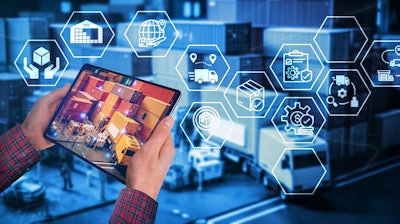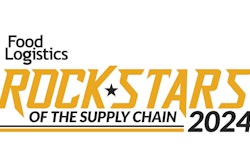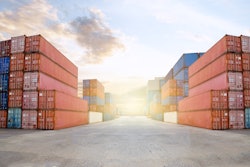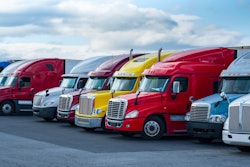
The food supply chain has changed significantly in the past 100 years, transforming from a largely manual, regionally based system to the sprawling, automated, high-tech global food supply chain of today. This evolution has had dramatic effects on types and quantities of foods. The USDA’s Economic Research Service, which maintains records of food production and consumption, reports that in 1909, 10.4 pounds of chicken were available per person in the United States. Thanks to new technologies and product development, by 2021, 68.1 pounds of chicken were available per person. In 1975, less than 5% of the vegetables consumed in the U.S. were imported. Contrast that with the time period between 2011-2021, when the percentage jumped to 35%, including nearly $6.9B in tomatoes, avocados, peppers and strawberries imported from Mexico alone.
While much has changed, the fundamental goals of the food supply chain remain the same: transporting food products to market at the lowest price while retaining peak freshness and quality. One of the keys to the transformation of the global food supply chain is data, and how the industry’s ability to harness, analyze, and translate data into comprehensive supply chain strategies has impacted the food supply chain.
Developing data-driven supply chain strategies begins with capturing data. While that may seem obvious, aggregating data from multiple, disparate systems and partners across a global supply chain is not a trivial undertaking. However, thanks to recent advancements in middleware technology, fourth-party logistics (4PL) and managed transportation services providers can leverage Integration Platform as a Service (IPaaS) technology to radically accelerate the systems integration and data capture process. In addition, sophisticated IPaaS technology can also cleanse, normalize, and store the data in a data lake or warehouse, making it available for reporting, analytics and strategy development. This easier access and visibility to holistic data has empowered business leaders to implement a variety of impactful strategies.
Predictive and prescriptive analytics
Shippers can increasingly leverage data and advanced technology for both predictive and prescriptive analytics. Predictive analytics leverages data, algorithms and machine learning to make predictions about future trends or events based on patterns in historical data. This can be especially useful as part of a forecasting exercise. Prescriptive analytics builds on predictive analytics by providing actionable recommendations that supply chain leaders can implement based on given inputs. There are a variety of technologies that support predictive and prescriptive analytics. Digital twin technology utilizes virtual models of systems, processes, and physical objects that simulate their “real-world” counterparts in real-time, allowing supply chain practitioners to postulate millions of “what if” questions and game out likely scenarios. The Internet of Things (IoT) uses sensors to track the movement of physical objects across the supply chain, creating valuable and specific data streams that can be fed into analytics models for processing. Robotic process automation (RPA) is software that automates repetitive tasks that were previously the work of humans. RPA can also be used to integrate data into analytics, making greater quantities of data available for analysis.
Forecasting
Demand forecasting has come a long way from the manual, paper-based and hunch-driven forecasting of the past. Today’s food supply chain leaders wield advanced analytics to accurately forecast consumer demand, which in turn drives manufacturing, inventory levels and locations, and transportation needs. Food producers are employing increasingly sophisticated demand sensing capabilities that leverage AI and incorporate data including market shifts, weather events, and changes in consumer behavior to inform forecasts. Social media is a major driver of food trends. For example, in 2020 a recipe for baked feta pasta went viral on TikTok, triggering a 200% increase in demand for feta cheese nearly overnight. Without demand sensing technology, feta producers would have been left scratching their heads in wonder as to why demand for their products had skyrocketed, and where they needed to position inventory to capitalize on the trend.
Inventory management and optimization
Social media is not the only source of inventory challenges for food producers. Crop failures, extreme weather, fertilizer shortages and geopolitical conflicts can all conspire to snarl even the best-laid plans. Despite advancements, the food industry is not immune to the impact of “Black Swan” events, such as the COVID-19 pandemic, that defeat even the most sophisticated forecasting models and threaten to leave store shelves unstocked. Conversely, excess inventory is nearly as great a challenge, as it can restrict a company’s cash flow and ultimately drive higher prices and make products less competitive. Real-time data empowers food producers to better manage inventories, allowing them to track inventory levels and shift product where it is more likely to be sold.
Optimization
Some of the most effective data-driven strategies leverage optimization and consolidation to reduce costs, increase efficiency and improve end-customer relationships. Load optimization, route optimization and mode optimization leverage many different types of data to maximize the efficiency of shipments by ensuring that the available space in a trailer or shipping container has been fully utilized, to plan and execute efficient routes, and to select the most suitable mode of transportation for each given shipment.
This can include data relating to:
· Historical shipment patterns, volumes, and destinations
· Vehicle capacity and constraints
· Product data, including parameters specific to food transport, such as temperature sensitivity and fragility
· Geospatial, traffic, and weather data
· Inventory and warehouse data
· Retail compliance, which is particularly important to maintaining customer relationships and avoiding costly chargebacks for shipments that are delivered early, late, and/or incomplete
· Transportation and fuel costs
· Trade regulations
· Carbon reduction goals
· Cargo security
Consolidation
Leveraging the data above, food shippers can also employ a variety of consolidation techniques to transport their products efficiently and cost-effectively.
· Truckload consolidation combines multiple less-than-truckload (LTL) shipments into a single, fully utilized truckload.
· Multi-stop truckload consolidates shipments from a single shipper to multiple retailers into a single truckload that makes multiple stops.
· Pool consolidation consolidates shipments from multiple shippers to multiple retailers within the same geography through a deconsolidation center.
The evolution of the food supply chain, driven by technological advancements and data utilization, has fundamentally transformed the industry. From predictive and prescriptive analytics guiding decision-making to real-time data empowering inventory management and optimization, the impact of data has been revolutionary. The ability to capture and leverage diverse data sets has not only streamlined operations but has also enhanced forecasting accuracy and facilitated cost-effective, efficient transportation through optimization and consolidation techniques. The modern food supply chain stands as a testament to the transformative power of data, ensuring a resilient and adaptive system that meets the demands of a dynamic global market.





















